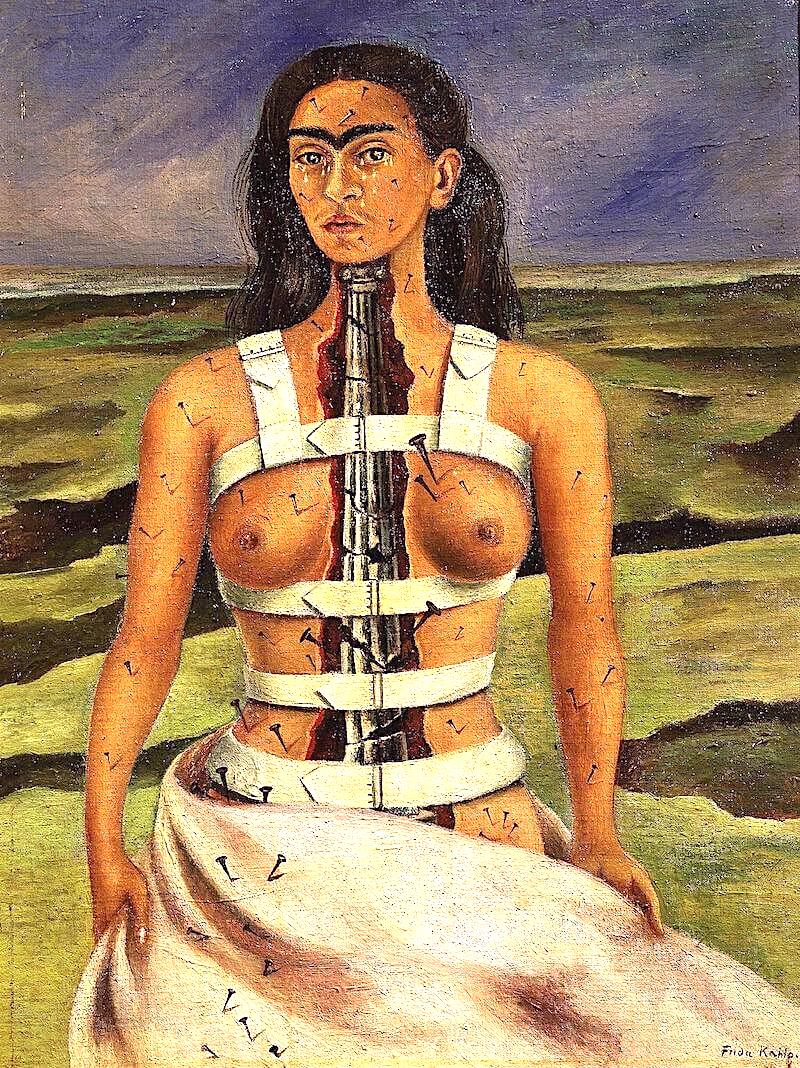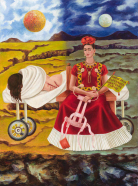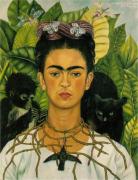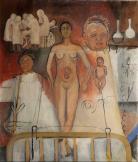Frida Kahlo's Life Journey
Created by Aneesa Estevez on Mon, 04/01/2024 - 12:30
This timeline provides a sociohistorical context for Frida Kahlo's 1944 The Broken Column

Kahlo, Frida. The Broken Column. 1944. https://www.fridakahlo.org/the-
broken-column.jsp. Accessed April 1, 2024.
Timeline
Chronological table
| Date | Event | Created by | Associated Places | |
|---|---|---|---|---|
| 1913 to 1946 |
Frida Kahlo's experience with PolioFor the first event that is connected to the artist, I have chosen a very personal event about Frida Kahlo which is about her poor health in her childhood. I used Frida Kahlo’s 1946 Tree of Hope, Remain Strong painting since she had not painted anything about her childhood health. Frida had contracted polio in the year 1913 at the age of six years old and had to be bedridden for nine months. Polio is an infectious disease that is caused by a virus, can spread from person to person, and causes paralysis or even death in some cases. Polio caused Frida’s right leg to grow thinner than her left leg, which also caused her to limp after she recovered from Polio. Frida became very insecure about her leg so she would wear long skirts to cover her legs for the rest of her life. Frida Kahlo has stated “I paint myself because I am often alone and I am the subject I know best.” This event can help someone understand the image because they are able to get a sense of Frida’s background and how her pain started at an early age and has had a big impact on her life. Frida Kahlo Biography, www.fridakahlo.org/frida-kahlo-biography.jsp. Accessed 17 Mar. 2024. Florida, Disability Rights. “Happy Birthday and Happy Disability Pride Month, Frida Kahlo.” Disability Rights Florida, disabilityrightsflorida.org/blog/entry/Frida_Khalos_6_Disability_Themed_Paintings#:~:text=In%201913%2C%20when%20she%20was,an%20outspoken%20and%20strong%20student. Accessed 1 Apr. 2024. |
Aneesa Estevez | ||
| 1913 to 1950 |
ExplanationThe reason that I offered that background concerning those three events is because it helps me explain what The Broken Column was trying to express and show its views when Frida Kahlo created it. We not only see in The Broken Column but in Frida’s other paintings as well that she focuses on painting portraits of herself and her life experiences/complications. Many of Frida's images represent her pain starting with her polio that she contracted at a very young age. She paints these portraits based off of her character, pain, and passion to express these events throughout the work of art. Throughout completing this project I have learned that Frida Kahlo’s bus accident was the reason for her creation of The Broken Column and that she was not alone when his accident occurred. Her boyfriend was with her during the time of the accident and it ended up having an impact on both their lives when Frida found out she was unable to become pregnant which not only affected her but her significant other as well. It was important to have the audience understand the meaning behind her paintings because it has expressed more than just her pain but it also showed her emotions and what has affected her. Yet through all the pain Frida had experience she somehow still showed hwo strong she was and the power she held by creating these paintings. These three events will allow viewers to understand Frida’s background from the beginning to end. |
Aneesa Estevez | ||
| The middle of the month Autumn 1925 to 1950 |
Frida Kahlo's Bus AccidentFor the second event that has to be connected to the image’s subject it is about Frida’s surgeries throughout that time period. I chose Frida Kahlo’s 1940 Self Portrait with Thorn Necklace and Hummingbird where it shows her with thorns around her neck to symbolize the pain she had experienced from her bus accident. Frida’s bus accident took place on September 17th, 1925. Frida was riding a bus with her boyfriend Gomez Arias when suddenly the bus crashed into a trolley which resulted in Frida having a broken spinal column, collar bone, ribs, pelvis, 11 fractures in her leg, and an iron hand rail punctured her abdomen and uterus. She had been put into a full boy cast which she spent 3 months in to recover from her injuries and her ability to walk had been affected for the rest of Frida’s life. Frida had gone through thirty five operations to fix her body after her accident. She painted herself when she had to wear special corsets to protect her back spine, Frida had to seek a lot of medical treatment for her chronic pain yet nothing had worked for her. She described herself as “naked and split down the middle”. Frida’s condition had only worsened from there on out. Continuing in 1950 where she was diagnosed with gangrene in her right foot which is death of body tissue due to lack of blood flow or bacterial infection. This event can help someone understand Frida’s image better because it allows them to understand that during the time Frida was creating this painting she was in physical pain. The image allows viewers to have a mental look at how it made her feel since others aren't able to experience it physically. Self Portrait with Thorn Necklace and Hummingbird, 1940, by Frida Kahlo, www.fridakahlo.org/self-portrait-with-thorn-necklace-and-hummingbird.jsp. Accessed 1 Apr. 2024. “The Accident - Google Arts & Culture.” Google, Google, artsandculture.google.com/usergallery/the-accident/tQIi_eBGGrS5IQ?hl=en. Accessed 1 Apr. 2024. |
Aneesa Estevez | ||
| 1931 |
Frida Kahlo's complications after the accidentFor the third event I chose Frida Kahlo’s 1931 Frida and the Cesarean (unfinished) painting. This painting represents a specific complication after Frida’s bus accident. In the painting “The Broken Column” she paints herself in a surgical brace with nails throughout her body, and tears running down her face to represent the constant pain she had gone through that year and moving forward. That complication was not being able to get pregnant and have children. Since the iron hand rail punctured Frida’s abdomen and uterus that has caused her complications with not being able to conceive. This image allows the viewers to have a better understanding of how the accident caused long-term issues for Frida and her body. Frida Kahlo Biography, www.fridakahlo.org/frida-kahlo-biography.jsp. Accessed 17 Mar. 2024. “The Accident - Google Arts & Culture.” Google, Google, artsandculture.google.com/usergallery/the-accident/tQIi_eBGGrS5IQ?hl=en. Accessed 1 Apr. 2024. |
Aneesa Estevez |



